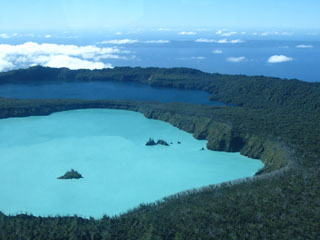Report on Ambae (Vanuatu) — 20 July-26 July 2011
Smithsonian Institution / US Geological Survey
Weekly Volcanic Activity Report, 20 July-26 July 2011
Managing Editor: Sally Sennert.
Please cite this report as:
Global Volcanism Program, 2011. Report on Ambae (Vanuatu) (Sennert, S, ed.). Weekly Volcanic Activity Report, 20 July-26 July 2011. Smithsonian Institution and US Geological Survey.
Ambae
Vanuatu
15.389°S, 167.835°E; summit elev. 1496 m
All times are local (unless otherwise noted)
Based on analysis of data collected by the Vanuatu Meteorology and Geohazards Department (VMGD), the Vanuatu Geohazards Observatory reported that a small series of explosions from Aoba occurred on 10 July. Photos showed that the volcano was quiet on 12 July, although ongoing earthquakes were detected. On 18 July the Vanuatu Volcano Alert Level (VVAL) remained at 1 (on a scale of 0-4).
Geological Summary. The island of Ambae, also known as Aoba, is a massive 2,500 km3 basaltic shield that is the most voluminous volcano of the New Hebrides archipelago. A pronounced NE-SW-trending rift zone with numerous scoria cones gives the 16 x 38 km island an elongated form. A broad pyroclastic cone containing three crater lakes (Manaro Ngoru, Voui, and Manaro Lakua) is located at the summit within the youngest of at least two nested calderas, the largest of which is 6 km in diameter. That large central edifice is also called Manaro Voui or Lombenben volcano. Post-caldera explosive eruptions formed the summit craters about 360 years ago. A tuff cone was constructed within Lake Voui (or Vui) about 60 years later. The latest known flank eruption, about 300 years ago, destroyed the population of the Nduindui area near the western coast.
Source: Vanuatu Meteorology and Geohazards Department (VMGD)

